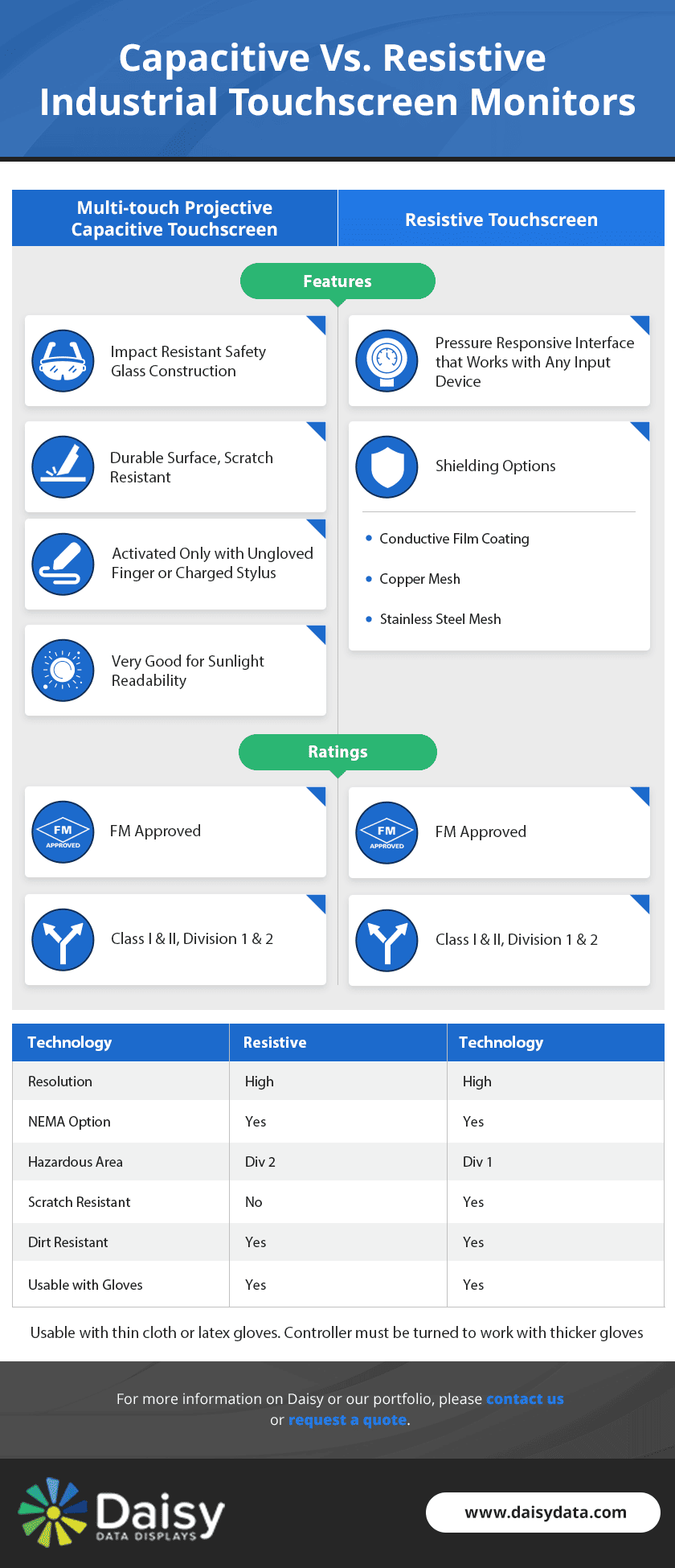Capacitive vs. Resistive Industrial Touchscreen Monitors
Industrial touchscreen monitors require specialized, high-performing technology. There are many varieties of touchscreen technology available, and identifying the most suitable type for a given application is crucial for ensuring improved device functionality. In industrial applications, two popular options are capacitive touchscreen monitors and resistive touchscreen monitors. This blog post will provide information on each type and discuss how to select the best option for your industrial application.
Projective Capacitive vs. Resistive Touch
While capacitive and resistive touchscreens may look similar on the surface, many qualities differentiate the two. Each features unique advantages and disadvantages that make them better suited for certain applications.
Projected Capacitive Touch
Projective capacitive touchscreens (PCAP) use the human body’s electrical properties as input. When the screen is touched with a finger or stylus, a small electrical charge is drawn to the point of contact, allowing the display to detect where it has received input. The result is a display that can detect light touches with greater accuracy than resistive touchscreens.
Advantages
Capacitive touchscreens are highly durable and feature a better display than resistive touchscreens. Even in sunlight, they offer good visibility and feature increased clarity and screen contrast compared to resistive screens. Capacitive screens are highly sensitive and feature multi-touch sensing functions, which means they are compatible with multi-point inputs. Other key advantages of capacitive touch screens include:
- Easy to use
- Support customization
- Easy to clean
- Can use gestures, such as pinch or zoom
- Pressure sensitive
Disadvantages
There are certain drawbacks to capacitive systems that should be taken into consideration. First, they are more costly than resistive touchscreen technology. Additionally, since they are so highly sensitive, they are easily activated at the lightest touch, which can result in accidental touches. Capacitive touchscreen views are best from the front of the display, and they cannot be used while wearing most types of gloves.
Resistive Touch
Resistive touchscreens use pressure as an input and are made up of several layers of flexible glass and polycarbonate.
The outermost layer is made from scratch-resistant plastic, with an inner layer typically made using glass. Both of these layers are coated in conductive material. When pressure is applied to the panel, resistance is measured between the two layers, highlighting where the point of contact is on the screen.
Advantages
Resistive touchscreens are a more affordable option than capacitive ones. They also work well at different angles and feature a greatly reduced likelihood of accidental touch compared to capacitive touchscreens. Other key advantages of resistive touch include:
- Can be used while wearing gloves
- Works well with a stylus
- Features a higher sensor resolution
- Continue to function correctly when liquid or debris is on the surface
- Highly durable
Disadvantages
Some disadvantages of resistive touchscreen monitors are that they are unable to respond to multi-touch sensing. Additionally, since they are less sensitive than capacitive touchscreens, they require the application of pressure to function. Their thick outermost layer results in reduced display quality and the screen are more easily damaged or scratched compared to capacitive. If they develop a small crack, they will not work and are difficult to repair.
Why Daisy Data Displays, Inc
Industrial PCs and monitors require touchscreen displays that address the unique challenges of their operating environments. Daisy designs its monitors to be serviceable. So as touchscreens wear out or become damaged, we can replace the touchscreens without having to purchase an entirely new unit. Capacitive and resistive touch technology are both accurate and easy to use, as well as compatible with network computers and most applications on a number of Windows systems.
Touchscreen monitors from Daisy Data Displays have been trusted by specialized industries for over 35 years. Our capacitive and resistive touchscreen displays are designed to provide lasting, reliable performance even in harsh operating environments. To learn more about our off-the-shelf products or custom solutions, contact us or request a quote today.


